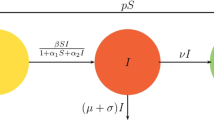Abstract
A mathematical model for Vibrio Cholerae (V. Cholerae) in a closed environment is considered, with the aim of investigating the impact of climatic factors which exerts a direct influence on the bacterial metabolism and on the bacterial reservoir capacity. We first propose a V. Cholerae mathematical model in a closed environment. A sensitivity analysis using the eFast method was performed to show the most important parameters of the model. After, we extend this V. cholerae model by taking account climatic factors that influence the bacterial reservoir capacity. We present the theoretical analysis of the model. More precisely, we compute equilibria and study their stabilities. The stability of equilibria was investigated using the theory of periodic cooperative systems with a concave nonlinearity. Theoretical results are supported by numerical simulations which further suggest the necessity to implement sanitation campaigns of aquatic environments by using suitable products against the bacteria during the periods of growth of aquatic reservoirs.




Similar content being viewed by others
Notes
Is a variance decomposition method (analogous to ANOVA): input parameters are varied, causing variation in model output. This variation is quantified using the statistical notion of variance \(s^2=\sum _{i=1}^{N}(y_i-\bar{y}){/}N-1\). where N = sample size (or equivalently, total number of model runs), \(y_i\) ith model output, and \(\bar{y}\) sample mean. The algorithm then partitions the output variance, determining what fraction of the variance can be explained by variation in each input parameter (i.e. partial variance).
References
Anguelov R, Dumont Y, Lubuma J (2012) Mathematical modeling of sterile insect technology for control of Anopheles mosquito. Comput Math Appl 64:374–389
Chitnis N, Hyman JM, Cushing JM (2008) Determining important parameters in the spread of malaria through the sensitivity analysis of a mathematical model. Bull Math Biol 70:1272–1296
Codeço CT (2001) Endemic and epidemic dynamics of cholera: the role of the aquatic reservoir. BMC Infect Dis 1:1
Colwell RR (1996) Global climate and infectious disease: the cholera paradigm. Science 274:2025–2031
Copasso V, Paveri-Fontana SL (1979) A model for the 1973 cholera epidemic in the european mediterranean region. Rev Epidem Santé Publ 27:121–132
Guillaume et al (2012) République d’Haïti, Ministère de la Santé Publique et de la Population: Direction Nationale de L’Eau Potable et de L’Assainissement. Plan d’élimination du choléra en Haïti
Hartley DM, Morris JG, Smith DL Jr (2005) Hyperinfectivity: a critical element in the ability of V. Cholerae to cause epidemics? Plos Med 3:e1
Huq A, West PA, Small EB, Huq MI, Colwell RR (1984) Influence of water temperature, salinity, and pH on survival and growth of toxigenic Vibrio Cholerae serovar O1 associated with live copepods in a laboratory microcosms. Appl Environ Microbiol 48:420–424
Islam MS, Rahim Z, Alam MJ, Begum S, Moniruzzaman SM, Umeda A, Amako K, Albert MJ, Sack RB, Huq A, Colwell RR (1999) Association of Vibrio Cholerae O1 with the cyanobacterium, Anabaena sp., elucidated by polymerase chain reaction and transmission electron microscopy. Trans R Soc Trop Med Hyg 93:36–40
Jifa J (1993) The algebraïc criteria for the asymptotic behavior of cooperative systems with concave nonlinearities. J Syst Sci Complex 6:193–196
Kaper JB, Morris JG (1995) Levine MM cholera. Clin Micro Rev 8:48–86
Marino S, Hogue IB, Ray CJ, Kirschner DE (2008) A methodology for performing global uncertainty and sensitivity analysis in systems biology. J Theor Biol 254:178–196
Mouriño-Pérez RR, Worden AZ, Azam F (2003) Growth of Vibrio Cholerae O1 in Red Tide Waters off California. Appl Environ Microbiol 69:6923–6931
Mushayabasa S, Bhunu CP (2012) Is HIV infection associated with an increased risk for cholera? Insights from a mathematical model. BioSystems 109:203–213
Mwasa A, Tchuenche JM (2011) Mathematical analysis of a cholera model with public health interventions. BioSystems 105:190–200
Pascual M, Bouma MJ, Dobson Andrew P (2002) Cholera and climate: revisiting the quantitative evidence. Microbes Infect 4:237–245
Reidl J, Karl Klose E (2002) Vibirio Cholerae and cholera: out of the water and into the host. FEMS Microbiol Rev 26:125–139
Roszak DB, Colwell RR (1987) Survival strategies of bacteria in the natural environment. Microb Ecol 51:365–379
Smith HL (2008) Monotone dynamical systems: an introduction to the theory of competitive and cooperative systems. American Mathematical Society, Providence, p 41
Tudor V, Strati I (1977) Smallpox, cholera. Abacus Press, Tunbridge Wells, p 313p
WHO (2017) Cholera. http://www.who.int/mediacentre/factsheets/fs107/fr/. Accessed 15 Aug 2017
Xu H-S (1982) Survival and viability of non-culturable Escherichia coli and Vibrio Cholerae in the estuarine and marine environment. Microb Ecol 8:313–323
Yibeltal NB (2009) A mathematical analysis of a model of cholera transmission dynamic. AIMS, Muizenberg
Author information
Authors and Affiliations
Corresponding author
Rights and permissions
About this article
Cite this article
Kolaye, G., Damakoa, I., Bowong, S. et al. Theoretical Assessment of the Impact of Climatic Factors in a Vibrio Cholerae Model. Acta Biotheor 66, 279–291 (2018). https://doi.org/10.1007/s10441-018-9322-2
Received:
Accepted:
Published:
Issue Date:
DOI: https://doi.org/10.1007/s10441-018-9322-2




